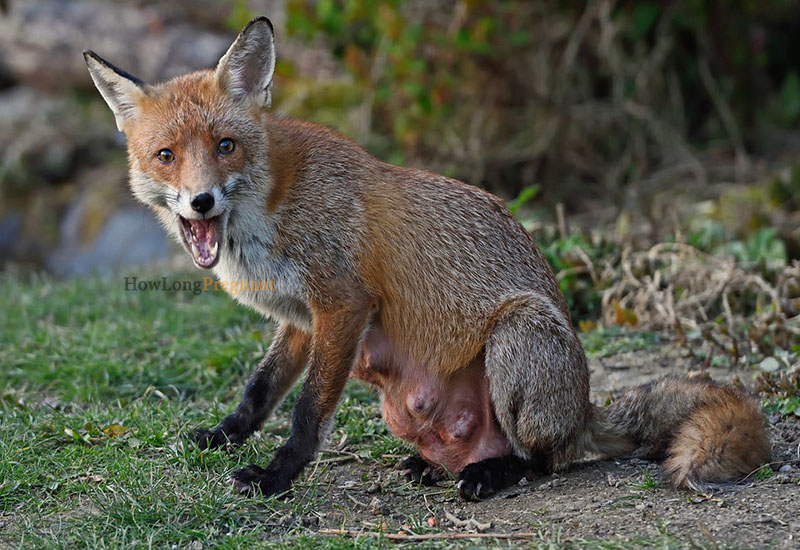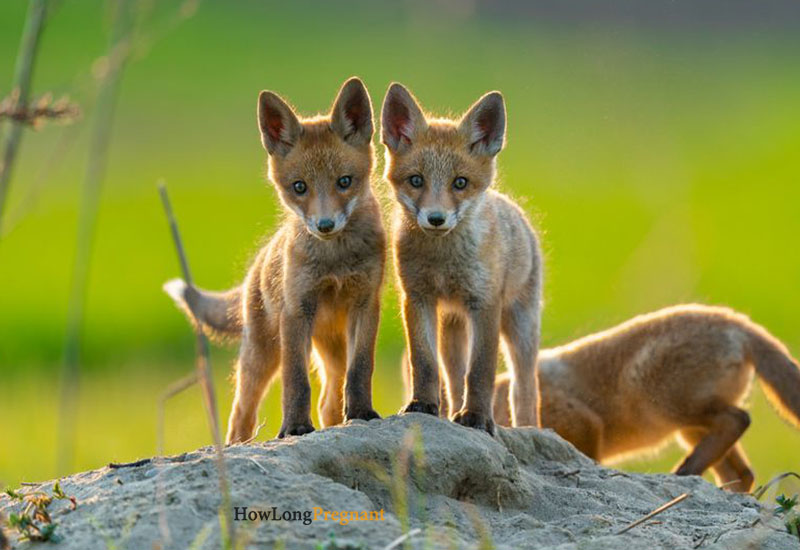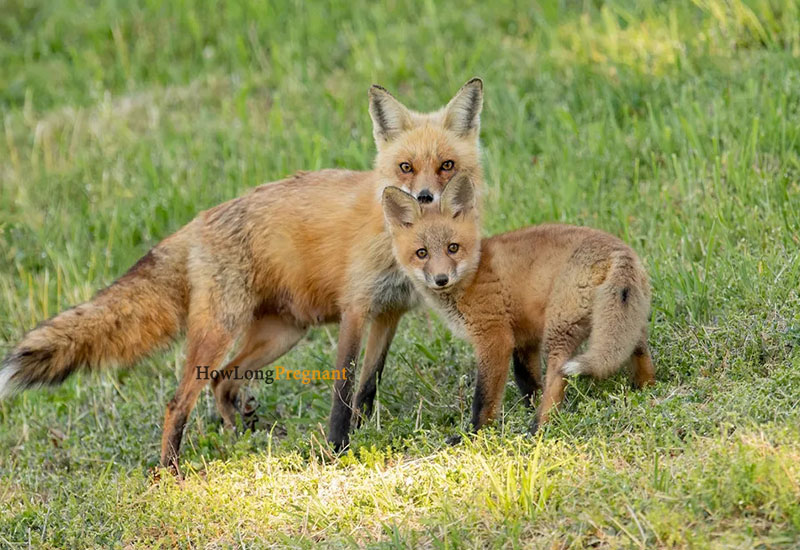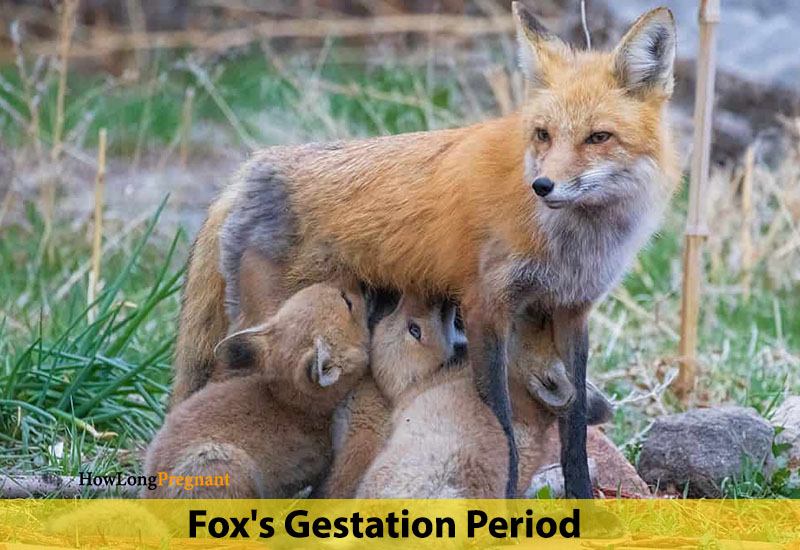The fox, with its fiery fur and mischievous eyes, has fascinated people for a long time. They are not just charming, but their life is also really interesting. One exciting part is when they are pregnant, which is called gestation.
This is a crucial time when new life is forming. In our journey of Exploring the Fox’s Gestation Period, we will uncover the secrets of how a playful fox mate transforms into a dedicated mother. We will dive into the world of hormones, see how they get ready for new babies, and witness the incredible journey from tiny, helpless kits to playful cubs.
You will get amazed by the amazing changes and scientific wonders that happen during this important time in a fox’s life. So, get ready for a fascinating ride, as exploring the Fox’s Gestation Period is about to reveal the special magic of this clever creature.
Mating Season
Foxes usually mate once a year, and when it comes to the dance of love, the timing varies depending on the type of fox and where they live. Red foxes, found in North America and Europe, start their love dance between January and March. Arctic foxes, who rule the snowy plains, prefer March to April.
On the other hand, desert-dwelling fennec foxes are ready for love all year round. Regardless of the season, the process is quite similar. Foxes attract mates using vocalizations, scent marking, and playful chases.
They engage in interesting competition dynamics, with males showcasing their skills to win over females, and scent playing a crucial role in fox courtship. When a fox couple forms a bond, they quickly get to the important part – mating, which only lasts a few seconds. That’s the fascinating story of foxes.
The Gestation Period
After foxes mate and it gets all exciting, something special happens to the female fox, called a vixen. The tiny egg that got fertilized starts splitting into more parts and then attaches itself to the mother’s uterus about 5 to 16 days later.

It’s like finding a cozy home where it can grow with the help of the mom’s body. And that’s when the magic begins, as this tiny thing starts turning into a baby fox, also known as a fox kit. It’s like a fantastic journey starting from a tiny egg to a little fox, all thanks to the warmth and care of the mother fox.
Different kinds of foxes have different lengths of time they carry their babies, called gestation periods. The red fox, which you might have heard about in stories, has a relatively short one compared to other dog-like animals, lasting around 52 days. Arctic foxes, who live in colder places, have a bit longer gestation period, ranging from 51 to 53 days.
Now, the tiny fennec fox is super quick, with the shortest pregnancy among all canines, delivering its babies after just 49 to 53 days. These differences show how adaptable foxes are, changing their baby-making schedules to fit where they live and survive in nature.
Also Read - Monkey's Gestation Period | How long are Monkey Pregnant
How Many Species of Foxes are There?
There might be a bit of difference in the count depending on how we group them, but usually, people think there are around 23 kinds of foxes. They are sorted into 6 groups called genera. Here is the list of some of the well known species of foxes and their gestation period:
- Red Fox: Gestation period: 51-53 days
- Arctic Fox: Gestation period: 51-53 days
- Fennec Fox: Gestation period: 49-53 days
- Gray Fox: Gestation period: 63 days
- Island Fox: Gestation period: 63 days
- Kit Fox: Gestation period: 50-53 days
- Swift Fox: Gestation period: 51-53 days
- Bat-eared Fox: Gestation period: 65 days
- Pale Fox: Gestation period: 50-53 days
- Blanford’s Fox: Gestation period: 50-53 days
Den Preparation
After the fun chase to find a mate, things change when the female fox, called a vixen, enters an important stage – pregnancy. The playful look in her eyes turns into a serious one, and she becomes really focused on being a good mother. This change isn’t just in her body but also in what she does.
She works really hard to get everything ready for her babies, finding and preparing a safe and cozy den for them. It’s like she’s getting all set to be the best mom she can be for her upcoming little foxes.
No more playing around and hunting for the female fox. Now, she’s on a serious mission to find a perfect place for her babies. It could be an old burrow, a safe spot in a log, or a little hidden space in the rocks. Once she picks the right spot, she doesn’t just stop there. Her mom instincts kick in, and she works really hard to make it super comfy and safe for her little ones.
She gathers soft things like leaves, grass, and feathers to make a cozy bed for her precious babies. Every move she makes shows how dedicated and loving she is. This change from being a clever hunter to a caring mom reveals that there’s more to her than just being sly and tricky. Underneath it all, there’s a mother’s strong love ready to bloom when the time is right.
Birth of Baby Fox
After waiting for weeks, the big day finally arrives for the female fox. She takes deep breaths and bravely brings her little ones into the world. The newborns are really small, covered in soft fur, and they can’t see or hear yet. They are super reliant on their mom for everything. The vixen gives birth to a litter of kits, typically ranging from 2-7 depending on the species and environmental factors.

Even though they seem tiny and helpless, there’s a spark of life in them – a little sound, a tiny movement – and that makes the mom fox feel super protective and caring towards them. It’s like a special moment when the magic of new life begins, and the mom is there to take care of her little fox family.
The mother fox doesn’t waste any time while taking care of her babies. She works really hard, giving them the special milk they need to grow strong. Whenever they make little sounds or move, she pays quick attention and keeps them warm. The playful energy she used to have is now all about keeping a close watch over her den.
It’s like a safe place she made out of love and determination to protect her little ones. Her senses are super sharp, always ready for anything that might be a danger to her babies. This quiet and careful way of being a mom shows how amazing nature is and the strong bond between a mom and her babies.
A Journey of Growth
Time quickly passes, and the little foxes start to wake up to the world around them. First, they could only see blurry shapes and lights, but now their eyes are getting better. They used to not hear anything, but now they’re surrounded by all sorts of sounds – little squeaks, chirps, and the comforting purr of their mom. The den, which used to be a quiet place, is now full of playful movements and clumsy adventures.
The tiny foxes start to explore, using their paws and sniffing around with their little noses. The mom fox, always keeping an eye out, is a strong support for them. She patiently helps them learn how to groom themselves and gives playful nips to teach them about hunting. She shows them the exciting parts of stalking, chasing, and the joy of a good meal they worked for.
As time goes by, the little playful foxes turn into sleek young cubs. Their soft fur changes to the kind of coat that shows what kind of hunters they’re going to be. When they stop relying on their mom’s milk, it’s a big step.
They go from needing her for everything to exploring on their own. The world outside the den, which used to be a mystery, now seems really exciting. With their mom keeping a close eye on them, the cubs start to play and chase each other, just like their parents did when they were looking for a mate.
The fun nips they got from their mom are now like friendly fights with their siblings, making them stronger and better at being foxes. Even though their mom feels a bit sad seeing them grow up, she knows it’s part of the plan – getting ready for a life outside the den, where they’ll carry all the lessons, skills, and survival spirit she taught them.
The journey from tiny, helpless kits to playful cubs shows how powerful growing up can be, thanks to a caring mom and the ongoing cycle of life in the secret world of the fox family.
Also Read - Leopard Gestation period and their pregnancy facts
Protecting the Future of Foxes
Revealing the mysteries of the fox’s gestation period goes beyond satisfying our curiosity, it is a crucial factor in their conservation. Keeping track of when foxes breed and the number of babies they have provides important information about the overall health of fox populations.

This data is a powerful tool for conservationists, helping them make smart decisions on how to manage and protect these creatures to ensure their survival. Identifying where fox dens are and preserving important habitats becomes essential to minimize disturbances from humans and protect the vulnerable baby foxes during their early stages of growth.
Ultimately, understanding this important phase strengthens our ability to ensure a bright future for these fascinating animals. The playful fox kits born today can grow into thriving contributors to the ecosystem of tomorrow.
FAQ
How long is a fox’s gestation period?
The gestation period varies depending on the fox species, typically ranging from 49 to 58 days. Red foxes and Arctic foxes stay pregnant for around 52 days, while fennec foxes have the shortest pregnancy at 49-53 days.
When do different fox species breed?
Breeding seasons also vary by species and location. Red foxes in North America and Europe breed between January and March, while Arctic foxes wait until March-April. Fennec foxes can breed year-round.
What happens during the gestation period?
Following fertilization, the egg implants in the vixen’s uterus and starts developing into a kit. Hormone levels fluctuate, preparing her body for pregnancy and eventual milk production. The vixen diligently prepares a den and gathers soft materials for her upcoming litter.
How many kits are typically born in a litter?
The number of kits varies based on the species and environmental factors. Red foxes have 2-7 kits, while fennec foxes have 1-5 pups.
How do the kits develop after birth?
Born blind and deaf, the kits rely on their mother’s milk and warmth for survival. Their senses gradually develop, and they start exploring their surroundings within weeks. The vixen teaches them vital skills like hunting and prepares them for independence by weaning them around 4-5 weeks old.
Why is understanding the gestation period important for conservation?
Monitoring breeding seasons and litter sizes provides valuable data on fox population health, allowing for informed management strategies. Knowledge of den locations and critical habitats helps minimize human interference and ensure the survival of future generations.
How can I contribute to fox conservation?
Supporting conservation organizations, reducing your ecological footprint, and spreading awareness about these fascinating creatures are all ways you can contribute.
Conclusion
As we finish talking about how baby foxes grow inside their mom, we learn something special. Behind the tricky and clever image of foxes, there’s a mom who works really hard to get ready for her new babies. From being tiny and needing help to becoming playful little foxes, it’s all because of the mother’s caring nature and the strong urge to survive. But it’s not just about being curious, understanding all this helps us take care of the foxes so they can keep living in the wild.
We become part of their story by protecting when they have babies, making sure their homes are safe, and being respectful when they’re raising their families. This journey doesn’t stop here; we should take this new appreciation and share it with others. We can also make choices that help foxes and their families, leaving a positive impact for the future. This way, the special moments of love, birth, and the strong spirit of the fox family can continue for generations to come, like a magical dance in the big web of life.

